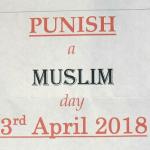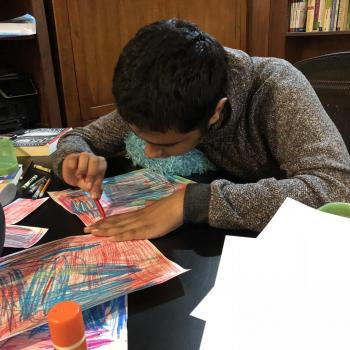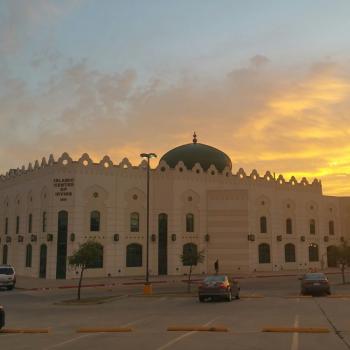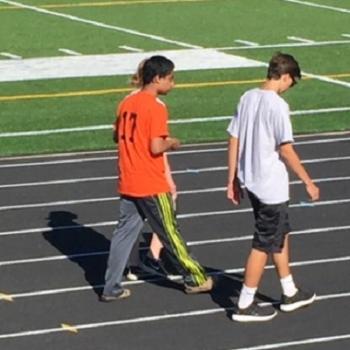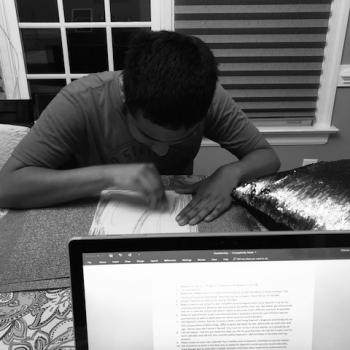First came the news of serial package bombings happening across the Austin, Texas, which had terrified the city and its surrounding suburbs for nearly three weeks in March of 2018, leaving two people dead. Then the bombing suspect, a young, white Christian male identified as Mark Anthony Conditt, killed himself with one of his own bombing devices in his SUV after he was cornered by a swat team.
In his death, he literally became a suicide bomber. And yet, as per the usual, words like terrorist, terrorism or any typical descriptors used in articles about Muslim suspects (and other minority groups) in similar cases were not used. And, as in past times in coverage of other violent attacks — like the mass shooting last fall at a church in Sutherland Springs, Texas, or recently in Las Vegas when Stephen Paddock killed 58 concert goers and injured hundreds others, or nearly three years ago when Dylann Roof murdered nine African Americans at the Emanuel African Methodist Episcopal Church in Charleston, South Carolina — Muslims, Blacks and other minority groups pushed back against the media coverage.
Why, asked many, is there such disparity in coverage? Why are words like “terrorism” or “terrorist” immediately used in articles about suspected violence by a Muslim? This time, with the Austin bombings, something out of the ordinary happened: The New York Times, in response to backlash of its coverage, invited readers to ask questions or post comments.
More than 2,000 people did just that.
However, while I appreciate the effort the New York Times made, I don’t think the reader feedback will elicit any definitive change in their reporting on these types of stories, or for that matter, change in most media outlets. Having worked as a journalist and editor for more than 16 years, covering American Muslim communities, I’ve seen this bias and problem in reporting perpetuated again and again.
What may elicit some modicum of change, or at least get people in the media and legal system thinking more objectively and smartly about this, are facts. Facts like how cases of attempted violence by those perceived to be Muslim receive seven and a half times more coverage from major media outlets and successful plots of violence were covered twice as much as compared to coverage of suspected violence by non-Muslim perpetrators.
Or, how perpetrators of ideologically-motivated violent plots who are perceived to be Muslim receive sentences four times longer than non-Muslims involved in similar cases. These are just a few of the findings in a new report from the Institute for Social Policy and Understanding (ISPU), titled “Equal Treatment? Measuring the Legal and Media Responses to Ideologically Motivated Violence in the United States.”
This groundbreaking report is full of pertinent data breaking down blatant discrepancies in how media and judicial systems report on or legally process acts of violence depending on the background of the suspect – with disproportional coverage or disadvantage when it comes to those perceived to be Muslim.
At the release of the report, ISPU fellow and co-author Kumar Rao said that the report exemplified everything so many in Muslim, Black and other minority communities have been saying all along. “We see this report about being about choices — draconian law enforcement practices against Muslim [and Black] communities … and most recently under the Trump administration, these acts of violence against immigrant communities. … We really see this report as about safety, policy and equality. … The safety of our communities who are often under attack, by law enforcement and hate crimes.”
I urge you to read and digest the valuable information contained in this report that pertains to the media and justice systems in the U.S. But for the purposes of this breakdown, and since I am a journalist and have been keenly aware of and tracking these issues from a media perspective, I want to focus on disparities in reporting. Let’s start by considering this comparison from the report’s executive summary:
In 2010, Justin Carl Moose, a self-described “Christian counterpart to Osama bin-Laden,” planned to blow up an abortion clinic. He was in possession of means to make explosives, including potassium permanganate, fuse wires, and metal shavings to make the explosive TATP.
And in May 2013, officials arrested Buford “Bucky” Rogers, who reportedly held white supremacist views and who law enforcement officials say cheered the Boston marathon bombing. Rogers made homemade bombs with the military-grade explosive PETN, crafted Molotov cocktails filled with “homemade napalm,” and had a loaded SKS rifle. He discussed using the weapons locally.
Most people have likely never heard of these two men, possibly because their plans received relatively little media coverage. Combined, the New York Times and Washington Post ran just two articles on Rogers. They printed no stories about Moose. Ultimately for their alleged plotted crimes, Rogers was sentenced to 40 months (3.3 years) in federal prison, and Moose was sentenced to 30 months (2.5 years).
Compare their cases to Antonio Martinez, who was alleged to have acted in the name of Islam when he planned to bomb a military recruitment station outside Baltimore and shoot personnel as they fled the scene. Law enforcement provided Martinez a fake bomb. Together, the New York Times and Washington Post published ten articles about Martinez. Martinez was charged with planning to use a weapon of mass destruction and was sentenced to 300 months (25 years) in federal prison.
Now consider some of these print media facts:
- Muslim-perceived perpetrators received twice the absolute quantity of media coverage as their non-Muslim counterparts in the cases of violent completed acts. For “foiled” plots, they received 770 percent the media coverage as their counterparts.
- Differences also extended to media references to a perceived Muslim perpetrator’s religion as compared to ideologies of perceived non-Muslims, mentions of specific phrases such as “terrorist” or “terrorism,” and coverage of the ultimate prison sentences.

This is just the tip of the iceberg, so to speak. I spoke with Carey Shenkman, co-author of the report and co-principle investigator, wanting to know what spurred this report to be written now. “The tendency is that the media throws around legal terms like ‘terrorist’ with much more freedom with Muslim-perceived perpetrator, and that’s something that never had numbers to back it,” he said.
Shenkman told me that some of the most significant findings in his opinion was the use of charge of weapons of mass destructions, in which they broke down suspects as category A, (Muslims who are purportedly acting in the name of Islam, and category B, who are non-Muslim perceived perpetrators:
What struck me the most was with the category B cases – a lot of them were gun fanatics, anti-government extremists, and they were stock piling weapons. They had assault rifles, some of them were engineers who were making their own bombs in garages.
Category A – you had kids who undercover law enforcements were giving them fake bombs, and on the other hand in category B, you had people who were making their own weapons, stock piling assault rifles. But category A people who were getting punished more severely. The people who were going through the lengths and making weapons who you think should be the people we are most afraid of and would be prosecuted — but this is not what happens.
Chances are a lot of prosecutors and judges, the only time they’ve encountered Muslims are as defendants. We talk about how our newsrooms don’t reflect the diversity of our general population. It’s worse in the legal system.
I also asked Shenkman about how although the report doesn’t mean to be a database of all ideological acts of violence or an attempt to define what “terrorism” is or what constitutes a “hate crime,” how does current definitions of terrorism factor into how reporting is done and what language is used?
“We did want to study the use of the word “terror” versus the use of the word “hate.” (on page 10 of the executive summary, page),” Shenkman told me. “It’s really staggering the differences in all the categories. We couldn’t even measure it for nonviolent perceived plots by category B because there was next to nothing on it.” He added,
“Something we do see a lot [is that] there will be debates on whether to call an incidence ‘terrorism,’ and a reporter will quote some law enforcement official saying this is hard to define, this doesn’t meet criteria, etc. It’s so unclear what this word means, but then this word gets thrown around so much in Muslim cases.
“There isn’t in terms of the media, a universal definition.”
Which is pretty much what the New York Times summary of reader comments to their Austin bombing coverage said, which doesn’t surprise me at all.
In The Intercept’s article on the ISPU report, they said,
This disparity in media and legal attention to cases of ideologically motivated violence has grown more troubling with the increase of violence carried out by sympathizers of the “alt-right” movement over the past several years. More than 100 people have been killed or wounded in the U.S. since 2014 by people believed to have been supporters of the “alt-right,” according to a February report from the Southern Poverty Law Center.
Supporters of a neo-Nazi group called Atomwaffen Division are alleged to have been responsible for recent murders, including the January killing of a young, gay, Jewish college student in California. Despite these acts of violence, however, the Department of Homeland Security under President Donald Trump has been working to strip funding from groups that work to mitigate far-right violence, while redirecting counter-extremism programming to focus exclusively on Muslim terrorism.
The disparities documented in the report help quantify a level of institutional bias in the legal system and media that many have argued exists in cases involving Muslim perpetrators.
Indeed. The disparities are well-laid out in the ISPU report, pretty much summarily and factually supporting everything I’ve seen in my own reporting and analysis of coverage. Shenkman and Rao both said that though the goal of the report isn’t to offer policy recommendations but rather stimulate discussions on what “equitable policy decisions should look like in relationship to the policies we make” as well as how the media covers violence when it comes to different communities.
I wonder if these discussions will be had.
Shenkman told me, however, that even to see The New York Times reaching out to its readers to delve deeper into the criticism of their Austin bombing coverage was astonishing. And, even if these discussions and ensuing changes are painfully slowly to come in newsrooms and courtrooms, what can happen more quickly are discussions in Muslim communities about which stake holders to engage with.


